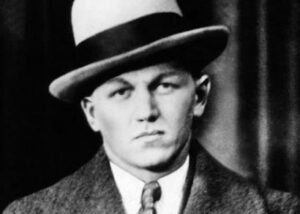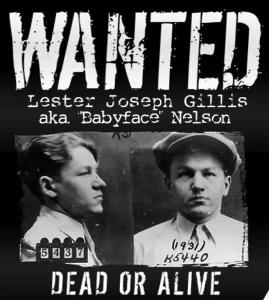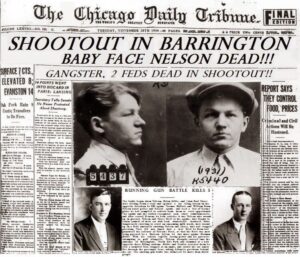 Lester Joseph Gillis may have had a baby face, but he was no innocent. The fact is that he seldom went by his real name. His alias was George Nelson and Baby Face Nelson. While he had a baby face, he was not a nice man, in fact, he was a cold-hearted killer, known for killing more FBI agents than any other criminal. Gillis was born in the Patch area of Chicago, Illinois on December 6, 1908. He was the seventh child of Belgian immigrants, Joseph and Mary Gillis. His father was a hardworking man, who worked in a tannery. Joseph strived to raise a loving family…but, somehow, with Lester, that proper upbringing didn’t work out so well. Lester’s first arrest occurred on July 4, 1921, at the age of twelve. In that incident, he accidentally shot a playmate in the jaw with a pistol that he had found. The situation was serious enough, that he served over a year in the state reformatory. When he got out at age 13, Nelson was quickly arrested again for car theft and joyriding at age 13. He was sent to a correctional school for an additional 18 months and released on April 11, 1924. Gillis’ family was horrified at his behavior, but Gillis was “on a roll” by then, and he didn’t care. He liked the “excitement” that a life of crime provided, and he wasn’t about to quit.
Lester Joseph Gillis may have had a baby face, but he was no innocent. The fact is that he seldom went by his real name. His alias was George Nelson and Baby Face Nelson. While he had a baby face, he was not a nice man, in fact, he was a cold-hearted killer, known for killing more FBI agents than any other criminal. Gillis was born in the Patch area of Chicago, Illinois on December 6, 1908. He was the seventh child of Belgian immigrants, Joseph and Mary Gillis. His father was a hardworking man, who worked in a tannery. Joseph strived to raise a loving family…but, somehow, with Lester, that proper upbringing didn’t work out so well. Lester’s first arrest occurred on July 4, 1921, at the age of twelve. In that incident, he accidentally shot a playmate in the jaw with a pistol that he had found. The situation was serious enough, that he served over a year in the state reformatory. When he got out at age 13, Nelson was quickly arrested again for car theft and joyriding at age 13. He was sent to a correctional school for an additional 18 months and released on April 11, 1924. Gillis’ family was horrified at his behavior, but Gillis was “on a roll” by then, and he didn’t care. He liked the “excitement” that a life of crime provided, and he wasn’t about to quit.
By the time he met his wife, Helen Wawrzyniak, Gillis (Baby Face Nelson) was working at a Standard Oil station in his neighborhood. Of course, that job wasn’t what it seemed either. The station doubled as the headquarters for a group of young tire thieves, known as “strippers” and Nelson fell into association with them. Through that association, Nelson acquainted himself with a number of local criminals. One of those criminals employed him to drive bootleg alcohol throughout the Chicago suburbs. Nelson quickly became a known member of the suburb-based Touhy Gang. All this happened by the time he was in his mid-teens. Very soon he became the Touhy Gang’s leader. In 1928, he married Helen Wawrzyniak, and they had two children, but that didn’t change his “bad boy ways” either. Within two years, Nelson and the gang were involved in organized crime, especially armed robbery. On January 6, 1930, the associates forced entry into the home of magazine executive Charles M Richter. After securing him up with adhesive tape and cutting the phone lines, they ransacked the house and made off with approximately $205,000 worth of jewelry, which would figure to approximately $3.3 million in 2021 dollars. Just two months later, they carried out a similar robbery at the bungalow of Lottie Brenner Von Buelow on Sheridan Road. This job netted approximately $50,000 worth of jewelry. After the crime, Chicago newspapers dubbed the gang, “The Tape Bandits.”
On April 21, 1930, Nelson and his gang robbed a bank for the first time. That take could hardly be considered  successful, at a mere $4,000. A month later, he and his gang netted $25,000 worth of jewelry from home invasions. On October 3, 1930, Nelson robbed the Itasca State Bank of $4,600…another disappointing take, and an even bigger problem, when a teller later identified him as one of the robbers. Three nights later, he brazenly stole the jewelry of the wife of Chicago mayor Big Bill Thompson, valued at $18,000. She also described her attacker, saying “He had a baby face. He was good looking, hardly more than a boy, had dark hair and was wearing a gray topcoat and a brown felt hat, turned down brim.” The net was beginning to close around Nelson. Then, he and his crew were linked to a botched roadhouse robbery in Summit, Illinois, on November 23, 1930.In the ensuing gunfight, three people were killed and three wounded. One might think that Nelson would lay low for a while, but three nights later, Nelson’s gang robbed a tavern on Waukegan Road, and Nelson committed his first murder, when he fatally shot stockbroker Edwin R Thompson.
successful, at a mere $4,000. A month later, he and his gang netted $25,000 worth of jewelry from home invasions. On October 3, 1930, Nelson robbed the Itasca State Bank of $4,600…another disappointing take, and an even bigger problem, when a teller later identified him as one of the robbers. Three nights later, he brazenly stole the jewelry of the wife of Chicago mayor Big Bill Thompson, valued at $18,000. She also described her attacker, saying “He had a baby face. He was good looking, hardly more than a boy, had dark hair and was wearing a gray topcoat and a brown felt hat, turned down brim.” The net was beginning to close around Nelson. Then, he and his crew were linked to a botched roadhouse robbery in Summit, Illinois, on November 23, 1930.In the ensuing gunfight, three people were killed and three wounded. One might think that Nelson would lay low for a while, but three nights later, Nelson’s gang robbed a tavern on Waukegan Road, and Nelson committed his first murder, when he fatally shot stockbroker Edwin R Thompson.
Throughout the winter of 1931, most of the “Tape Bandits” were rounded up, including Nelson. The Chicago Tribune referred to their leader as “George ‘Baby Face’ Nelson” who received a sentence of one year to life in the state penitentiary at Joliet. Refusing to be held, Nelson escaped during a prison transfer in February 1932. Through his contacts within the Touhy Gang, Nelson fled west to Reno, where he was harbored by William Graham, a known crime boss and gambler. He began using the alias “Jimmy Johnson” at this point. Nelson…now Johnson went to Sausalito, California, where he worked for bootlegger Joe Parente.
Nelson decided that it was time for him to have a gang of his own after the Grand Haven bank robbery. Nelson used his connections at the Green Lantern Tavern in Saint Paul, to recruit Homer Van Meter, Tommy Carroll, and Eddie Green. With his new gang, and with the addition of two other local thieves, Nelson robbed the First National Bank of Brainerd, Minnesota on October 23, 1933. The take on that robbery was $32,000, or approximately $670,000 in 2021 dollars. It was reported that Nelson wildly sprayed sub-machine gun bullets at bystanders to facilitate his getaway. Then, he picked up his wife, Helen and four-year-old son Ronald, and left with his crew for San Antonio, Texas. In San Antonia, he and his gang bought several weapons from a crooked gunsmith Hyman Lehman, one of which was a .38 Super Colt pistol that had been modified, so it was fully automatic. That gun was used by Nelson to kill Special Agent W Carter Baum at Little Bohemia Lodge several months later.
On December 9, 1933, a local woman tipped off San Antonio police regarding “high-powered Northern gangsters” in the area. Tommy Carroll was cornered two days later by two detectives who opened fire, killing Detective H.C. Perrin and wounding Detective Al Hartman. At that point, the gang split up with all the Nelson gang, except Nelson, leaving San Antonio. As a way to distance himself from the gang, Nelson and his wife traveled west to the San Francisco Bay Area. The prior close call didn’t slow him down, however. In San Francisco, he recruited John Paul Chase and Fatso Negri for a new wave of bank robberies the following spring. The next winter found him in Reno, where he met the vacationing, Alvin Karpis. Karpis introduced him to Midwestern bank robber Eddie Bentz. Teaming up with Bentz, Nelson returned to the Midwest the next summer.  On August 18, 1933, Nelson committed a major bank robbery in Grand Haven, Michigan. It was his first robbery in the area. The robbery was pretty much a failure…but it was a successful failure, because most of those involved made a full escape.
On August 18, 1933, Nelson committed a major bank robbery in Grand Haven, Michigan. It was his first robbery in the area. The robbery was pretty much a failure…but it was a successful failure, because most of those involved made a full escape.
Gillis Helped John Dillinger escape from prison in Crown Point, Indiana, and then became his partner. Nelson and the Touhy Gang were collectively “Public Enemy Number One” by the FBI. The alias, “Baby Face Nelson” came from Gillis being a short man with a youthful appearance. Still, in the professional realm, Gillis’ fellow criminals addressed him as “Jimmy.” On November 27, 1934, FBI agents fatally wounded and killed Baby Face Nelson in the Battle of Barrington, which was fought in a suburb of Chicago, Illinois.


Leave a Reply